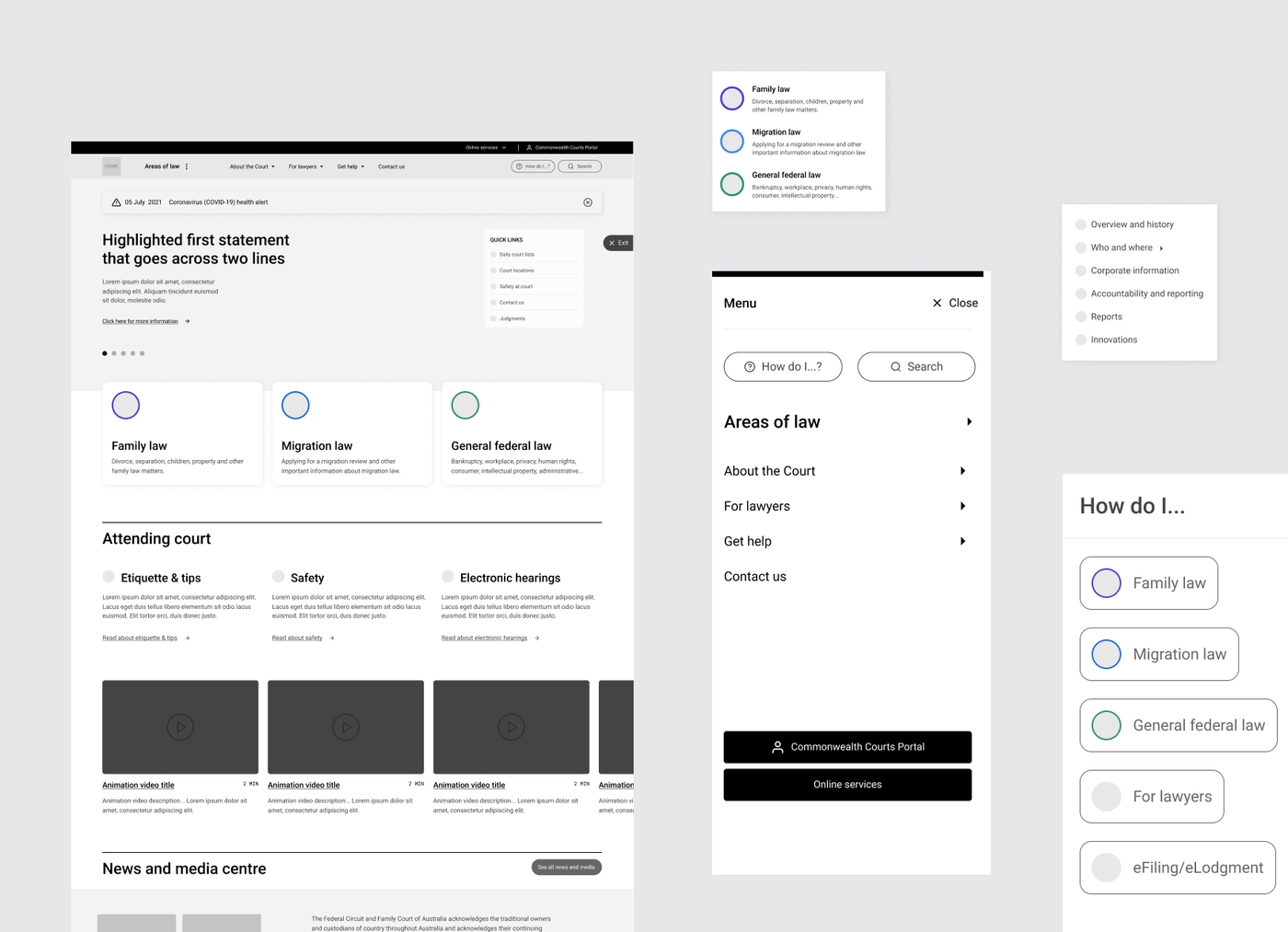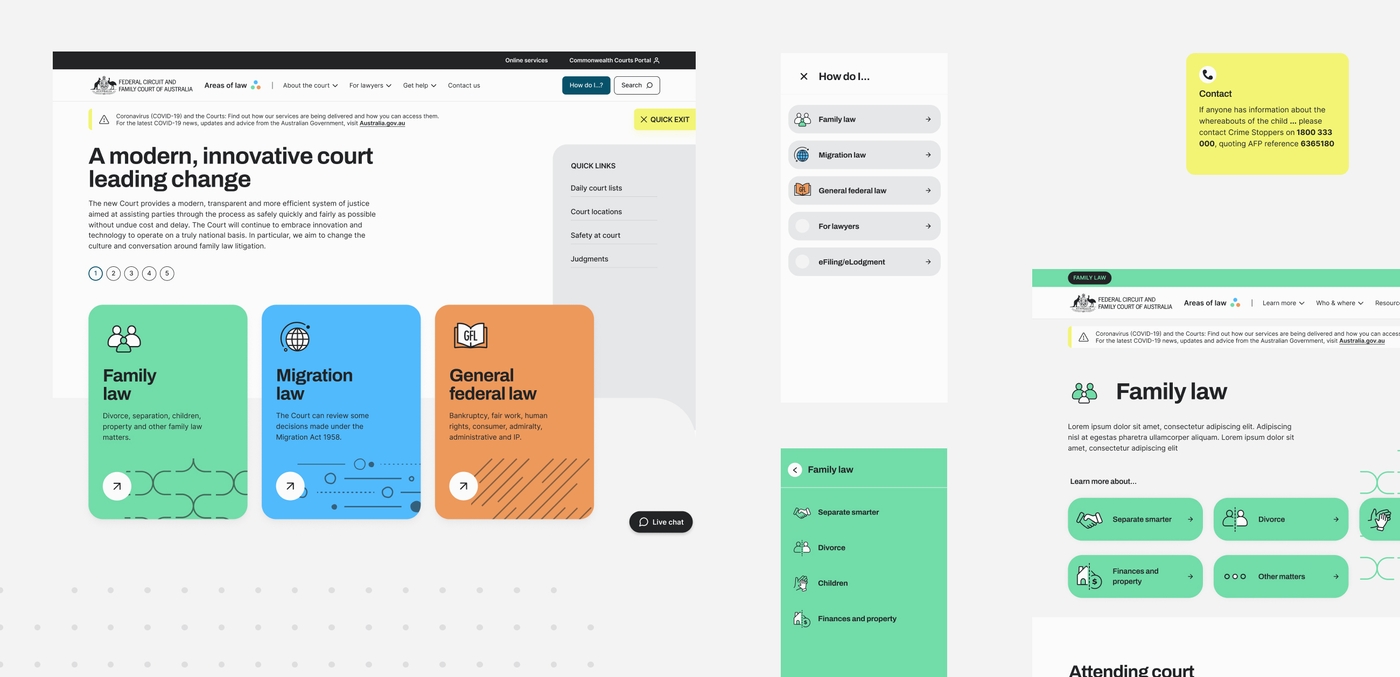On 18 February 2021, the Australian Parliament passed a Bill that saw the creation of a new single court structure, the Federal Circuit and Family Court of Australia (FCFCOA), combining the existing Federal Circuit Court of Australia and Family Court of Australia.
The FCFCOA was created to be innovative, fair and efficient and focuses on risk, responsiveness and resolution by:
- Improving early risk identification and safety of children and vulnerable parties
- Enhancing national access to justice for vulnerable parties and regional communities through the use of technology, and
- Aiming to resolve up to 90 per cent of cases within 12 months.
Portable was engaged due to its extensive work in the delivery of justice and legal services throughout Australia, including being a digital partner of Legal Aid NSW, Victoria Legal Aid, the Fair Work Commission, Commonwealth Ombudsman, and Victorian Legal Services Board, to name a few.
Portable’s significant investment into the justice sector includes an established legal design practice that proactively takes part in the research, co-design, and development of new initiatives which seek to make a positive impact in the sector. This dedication is exemplified in the design and development of amica, a digital platform which empowers previously married or de facto couples to separate online, which was launched in June 2020 and won the National Award for Best Government Service Delivery at the 2020 iAwards.
The Challenge
The Federal Circuit and Family Court of Australia engaged with Portable to support the design of a new website to act as a single point of entry for people engaging with the Australian family law system, supported by a set of consistent rules, processes and procedures covering a variety of jurisdictions.
As the website was to serve as the fundamental platform for branding the newly-created Court of Australia, a number of requirements were set out:
Unify the look, feel and digital presence under the new brand
Prior to the introduction of the FCFCOA, both the Family Court of Australia and the Federal Circuit Court had their own dedicated website, social media accounts, communications, application rules, and best practices. Creating a unified brand identity that merged these successfully meant considering:
- Target Audiences
- Brand Direction
- Tone of Voice
- Digital Experience
- Branding and Marketing
Simplify user engagement with UX and IA that follows a series of complex requirements
With more than 120,000 unique applications expected to be filed in the first year of the website’s operation, it was imperative that a streamlined digital experience was introduced which directed users to the appropriate pathway in as few clicks as possible.
All User Experience (UX) and Informational Architecture (IA) delivered was required to follow complex regulations and guidelines outlined by the Commonwealth.
Rely on industry expertise due to working with a tight deadline
A critical component to the success of the project was to ensure all deliverables met the prescribed deadline which was set for the public launch of the website and handover of all branding assets, aligning with Federal announcements and the official formation of the Federal Circuit Family Courts of Australia.
Our Approach
Working to ensure that all deliverables would be handed over and the FCFCOA website launched prior to the prescribed deadline meant that it was critical we lean on the expertise of the Portable Justice Team at each stage of the project.
Project Management
Leveraging an agile approach to the design, iteration and development of the branding, UX, Information Architecture, and final website was key to our success in delivering this project.
We also collaborated with key partners in our network including govCMS for UX and wireframes, Oxide for the development of the website, and Sal Balharrie of Naked Emperor, who worked to lead the process with Courts, to help bring the design to life in a launch campaign.
Information Gathering
In order to support the Federal Circuit and Family Court of Australia’s goal of unifying their brand and streamlining the way users engaged with services online, we began the project by liaising with key stakeholders and performing a deep dive into the extensive documentation made available during handover including workshop outputs, user surveys, and draft website content.
We worked in collaboration with the FCFCOA to audit the existing website architecture and provide detailed feedback to help guide the design of a finalised site map which would dictate the content made available on the website and the journey with which the average user would undertake when seeking a particular outcome.
Wireframing
The goal of the wireframing phase was to apply a human-centred design approach to building a strategy which would address the needs of the intended audience while meeting objectives set by the FCFCOA. The wireframes were initially provided in a low-fidelity format which focused on the page structure, allowing Oxide to begin the development of key pages while our team moved to finalising high-fidelity page designs for the new website.
The wireframes featured key information based on the outcomes of our deep-dive into the existing documentation and research that was supplied in addition to the structure of content that would be best suited for simplifying the user journey for those engaging with the website.
This included the framing of 10 unique key pages which would be used to dictate the standardised layout of the website moving forward.

Visual Direction
While our development partner began working on the structure of the intended live pages using the outcomes from the previous phase, our design team worked to create visual direction which was applied to a home page template.
Leveraging the learnings from dozens of recent design projects that our Justice Team had successfully completed over the years, we were able to confidently create a visual guide for the FCFCOA with just a single round of feedback required by key stakeholders and minimal changes to the final product.
This was then expanded to match the 10 unique key page templates that had been supplied to Oxide to develop, again requiring little input from the FCFCOA stakeholder group, ensuring that the goals and outcomes were aligned with the deliverables provided.
To support the FCFOA’s needs for a brand that could be applied to a wide range of users across a variety of areas, the brand and style guide was expanded to include:
- Component library (buttons, forms, etc.)
- Icons
- Type system
- Colour system
- Breakpoint system
- Spacing system

Support
Collaborating with Naked Emperor, we assisted in the design of numerous external assets which aimed to support the launch of the new Federal courts with clear and accessible documentation that outlined the requirements, procedures, and processes that were to be introduced under the FCFCOA.
We continued to provide ongoing support to Oxide, the development partner, leading up to the launch of the newly-designed website including the supply of design enhancements and attending any workshops, meetings, or discussions, as required.
Outcomes
The website has since launched and is successfully supporting the activities of the newly-formed Federal Circuit and Family Court of Australia, providing streamlined engagement to users seeking online support and digital services within the relevant jurisdictions.
The updated brand and style guide, including the expanded component libraries, continues to aid in providing an improved user experience which considers the sensitive situations and varying levels of digital literacy that exist within the stakeholder group.
The successful design, iteration, development, and rollout of the new website and branding guidelines for the Federal Circuit and Family Court of Australia act as an industry-wide example of how partnering with providers who have extensive experience and expertise relevant to the industry can play a critical role in the deliverability and success of complex projects, particularly when working with prescribed deadlines or significant requirements.

Looking Forward
The successful delivery of the FCFCOA branding and website serves as a model use case for the value of legal design and rapid iteration through collaboration between industry experts and relevant stakeholder groups.
The outcomes achieved should serve to guide the courts of Australia and the wider justice sector to take a user-first approach when seeking to truly meet the needs of the Australians in which they serve.
We look forward to working with representatives within the Courts of Australia and across the justice sector to enact positive systemic change through the application of human-centred design principles and development of ethical technology solutions which support the ongoing digital transformation of services supplied to the Australian public.
Project Team
- Shayla Kappelle, Lead Producer
- Jake Hogg, Design Lead
- Guillermo Soria, Digital Producer
- Simon Goodrich, Principal Client Partner
- Joe Sciglitano, Head of Design
- Luke Thomas, Senior Legal Designer